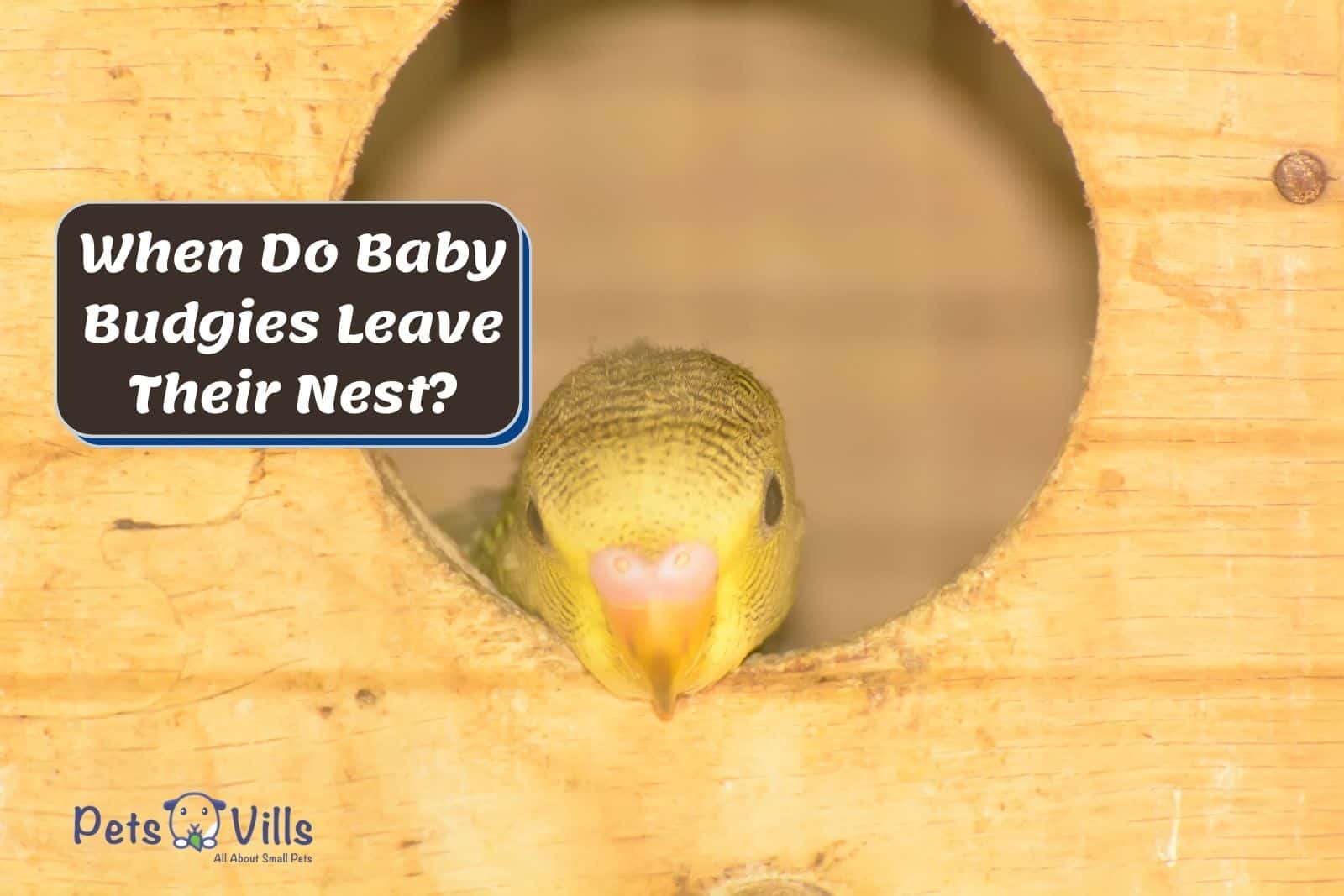One of the most exciting things about raising a baby budgie is watching them take their first flight from the nest. But when do baby budgies leave the nest?
For first-time budgie breeders, it can be hard to know when it’s time for their little one to fly the coop.
I was in the same situation as you a while back. So, I can guide you on everything you need to know about raising a budgie brood.
I’ll also detail how to care for the helpless chicks until they can fend for themselves.
Read on!
Table of Contents
When Can Budgie Chicks Leave Their Mother?

Generally, most budgies leave their nests at 8 to 10 weeks after hatchling, but most don’t wean until 4 to 6 weeks.
So, baby budgies will leave the nests when they can eat solid foods without the help of their mothers.
Budgies will also leave their nests when they’ve grown feathers and can fly.
Budgies are born naked, pretty much featherless. They’re also blind and helpless.
So, they’re very vulnerable and utterly dependent on their parents for survival in the first few weeks.
Thus, separating the chicks from their parent may put pressure on both their mental and physical health.
At 8 weeks old (1), a budgie is independent and won’t need its mother’s feeding, warmth, and comfort.
For example, an 8-week budgie has developed feathers to regulate its body heat better.
But, 8 weeks is the bare minimum age. It doesn’t hurt to extend the stay. Most budgie owners prefer to extend the stay between the chicks and their mothers to 12 weeks.
Another thing to keep in mind is there’re always birds of different sizes in the nest. Some may take longer to wean and grow independent than others.
Therefore, if applicable, I recommend waiting for the 12-week mark before separating your budgie chick from its mother.
READ MORE: What Fruits Can Budgies Have?
Baby Budgie Growth Stages Explained
Budgies grow quickly, but they’ve to go through all the five development stages (2) before leaving their nests.
Some of the significant milestones in their development are:
Day 7: Gain the strength to hold up their heads.
Day 10: Open their eyes, and grow soft feathers down to help keep warm.
Day 14: Grow pin feathers
3 to 4 weeks: Develop full feathers.
In the section below, we’ll detail each of the stages.
Stage 1: Neonate
Neonate, also known as the hatchling stage, is the first budgie development stage.
As with any other altricial organism (3), budgie babies are hatched in an immature state. They can hardly care for themselves.
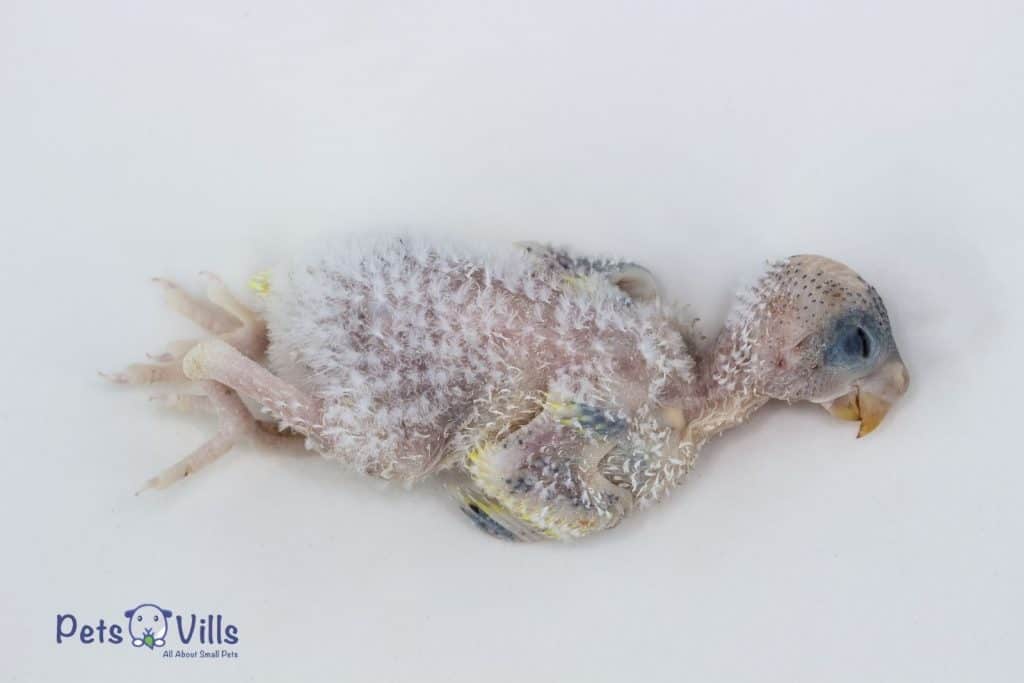
For example, their eyes remain closed, lack feathers, and are deaf and blind. Simply put, they’re entirely dependent on parental care.
At the neonate stage, budgies feed their chicks by regurgitating food. Usually, the meals are in liquid form from the bird’s cop.
The regurgitated food (4) is also known as budgie milk and is the avian equivalent of a mammal’s milk. It contains all the essential nutrients and antibodies to develop the chicks.
Nature also makes it possible for the budgie to vary the consistency and content of the budgie milk to cater to the different nutrient needs of the brood from the youngest to the eldest.
Stage 2: Nestling
During the nestling stage, baby budgies open their eyes and are a teeny bit more capable of taking care of themselves than in the neonate stage.
However, they’re still entirely dependent on their parents for survival.
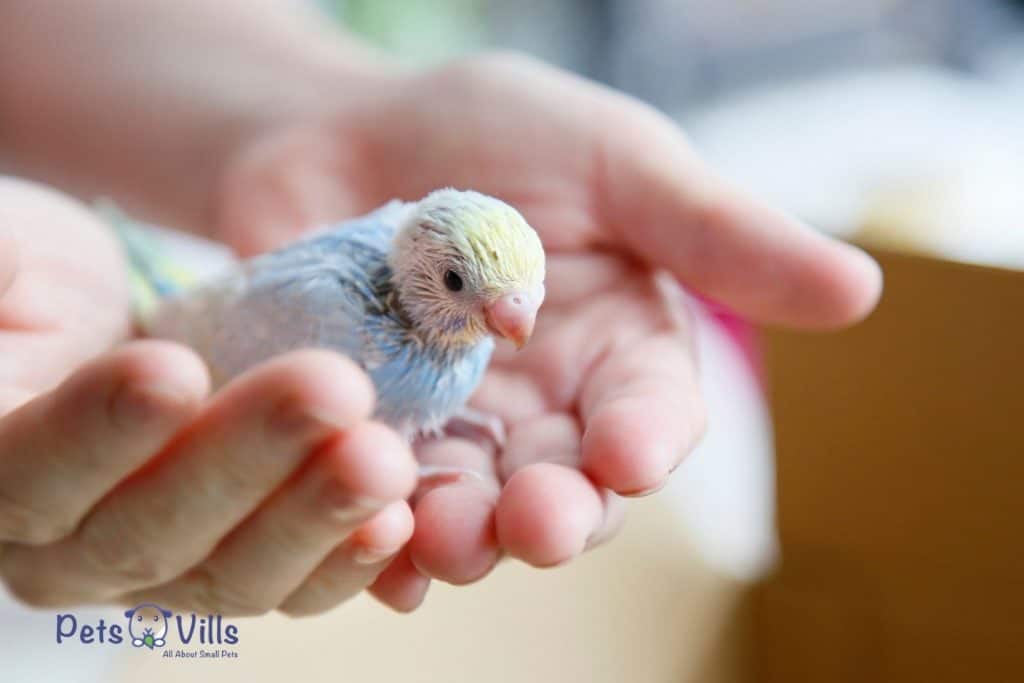
Budgies at the nestling stage also have more actual feathers but might be covered in a capsule or coating to indicate they’ve just sprouted.
Towards the end of the nestling stage, baby budgies get more active inside the nest but aren’t ready to fly yet.
So, as with new hatchlings, if you find a nestling on the ground, the best thing to do is return it to the nest.
Stage 3: Fledgling
At the fledgling development stage, baby budgies are ready to fly and strike out independently.
However, they’re not ready to fly yet but can hop, flutter, and walk.
Usually, they’ll leave their nest to practice flying and forage but still stay within the confines of the nest area.
The fledglings also have most of their adult feathers, but they aren’t developed fully. The wings and tail look “stubby.”
At this stage, the baby budgies initiate more interaction with their parents and siblings, necessary for social development.
Stage 4: Weanling
The weanling stage starts at week 3 to 4 after hatching.
At this stage, a baby budgie can interact independently with the brood and parents and doesn’t need continual nurturing support.
Baby budgies at the weanling stage will even start to eat solids and develop their foraging skills.
Stage 5: Juvenile
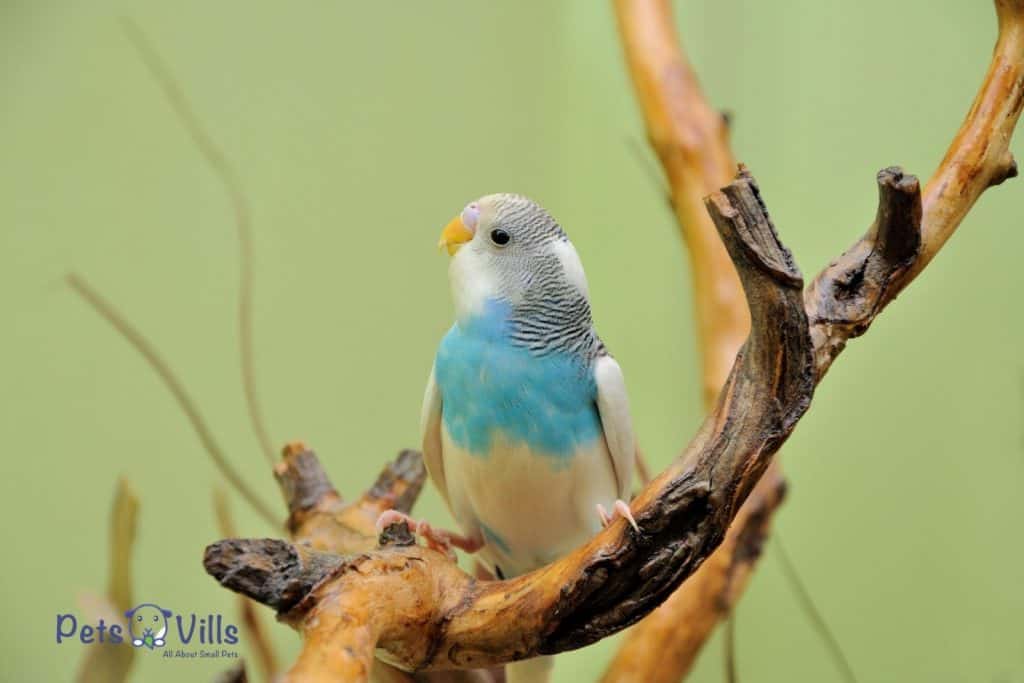
The juvenile stage is where budgies are not quite considered a baby, but not an adult either.
Budgies at this stage are pre-adolescents and have mastered all the skills for independent survival, like fending for themselves and flying.
At this stage, they can comfortably live off the solid foods and won’t require a formula.
However, juvenile budgies aren’t full-grown yet, and their maturity markings, such as adult color, haven’t developed yet.
Stage 6: Adulthood
Budgies are considered adults when they’re sexually mature, meaning they can reproduce.
The other defining feature of an adult budgie is the complete markings of adults. For example, the fully developed feathers.
Adulthood is usually the longest stage in a budgie’s life before dying.
Check out this amazing timelapse!
CHECK: Best Time of the Day to Remove Bird Nest
Risks to Consider Before Baby Budgies Leave their Nest
Baby budgies are delicate creatures, and sometimes, there’s a lot that can go wrong before they leave their nests.
Some of the common risks include:
1) Starvation
Budgies instinctively know how to rear their baby chicks, but some aren’t good parents.
Sometimes, budgies will lose interest in their young ones and stop feeding them.
If the mother abandons their kids, they’re likely to die from starvation.
Therefore, if you’ve birds in captivity, it’s always good to observe the mother budgie and see whether it’s regurgitating food to its young ones.
Here’s how to hand feed your baby budgies.
2) Temperature Changes
Baby budgies are susceptible to temperature changes because they lack feathers and enough body mass.
Baby budgies may die when the conditions get too hot or too warm.
Even chicks that aren’t abandoned may also die from the wrong temperatures. It’s essential to keep the ambient temperatures for baby budgies at 98 degrees Fahrenheit.
Sometimes, it gets too cold for the mother budgie to keep the chicks warm when they sleep. In such cases, keep the budgies warm by using a brooder lamp or a humidifier or raising the temperature of the entire room.
Related: Budgie Sleeping Positions
3) Underdeveloped Immune System
Baby budgies have a less developed immune system and are prone to infections.
Cleaning the nest area is necessary, given that most bacteria and viruses thrive in unsanitary conditions.
Ensure the nesting box is clean, food and water are replenished regularly, and proper ventilation.
READ MORE: What’s the Average Lifespan of a Budgie?
Frequently Asked Questions
What age do baby budgies eat seed?
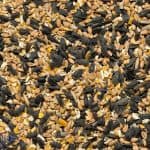
Generally, baby budgies will start to crack and eat seeds around 4-6 weeks of age. At week 5, you can start putting food on their feeding bowls and let the budgie indulge in its instinct to forage.
How long do budgies feed their babies?
Most budgies will feed their chick for 3 to 4 weeks of age. By the end of the 4 weeks, budgie chicks have already developed foraging skills and can eat solid foods.
How can you tell how old a budgie is?

Mature budgies have fully developed irises, adolescents have dark irises, while babies have no iris.
The surest way of knowing a budgie’s exact age is by examining their leg band or contacting the breeder or pet store owner from whom you purchased the bird.
Conclusion
So, when do baby budgie leave their nests? Generally, budgies will leave their nests when they’re fully developed and can fend for themselves. It’s usually by the 12th week.
So, unless your budgie has a special condition, you shouldn’t have any problem transferring them to their cage by then.
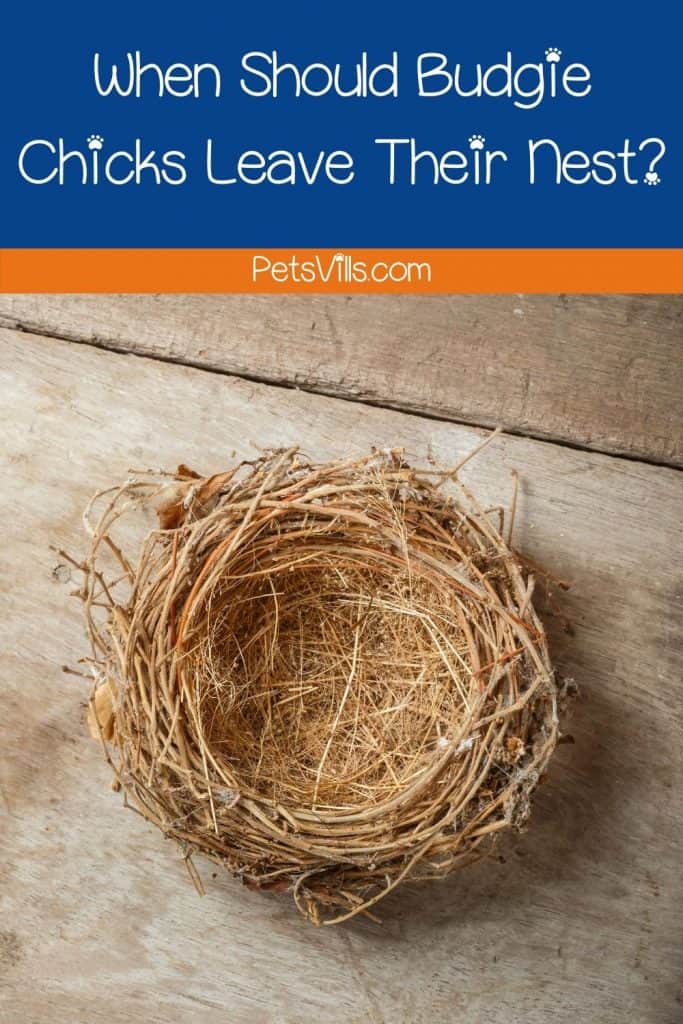
What do you think of baby budgies? Let us know below!
Resources
- 1. How do you wean a baby parakeet? – Riunitedformarriage.org [Internet]. riunitedformarriage.org. [cited 2022 Apr 28]. Available from: https://riunitedformarriage.org/how-do-you-wean-a-baby-parakeet/
- 2. Hand-rearing and rehabilitation of Plum-headed parakeets, contd. – Rehabber’s Den [Internet]. www.rehabbersden.org. [cited 2022 Apr 28]. Available from: http://www.rehabbersden.org/index.php/36-pages/pricing-table/simple/244-hand-rearing-and-rehabilitation-of-plum-headed-parakeets-contd
- 3. Sleigh M. Altricial. Encyclopedia of Child Behavior and Development. 2011;80–0.
- 4. Birds keep busy feeding their young during the breeding season / RHS Gardening [Internet]. www.rhs.org.uk. [cited 2022 Apr 28]. Available from: https://www.rhs.org.uk/advice/advice-blogs/wildlife-in-my-garden/April-2017/young-birds-being-fed
Barry Stingmore is a British content writer living in Fuerteventura, Spain. An animal lover at heart, he shares his home with a dog and four rescue cats and has a passion for writing about animals big and small.
Barry loves finding answers to your animal-related questions, the more research involved the better! You can rely on him to find the facts.
Find him on FACEBOOK, TWITTER AND Linkedin
Read his latest ARTICLES.
Find more about him HERE.

